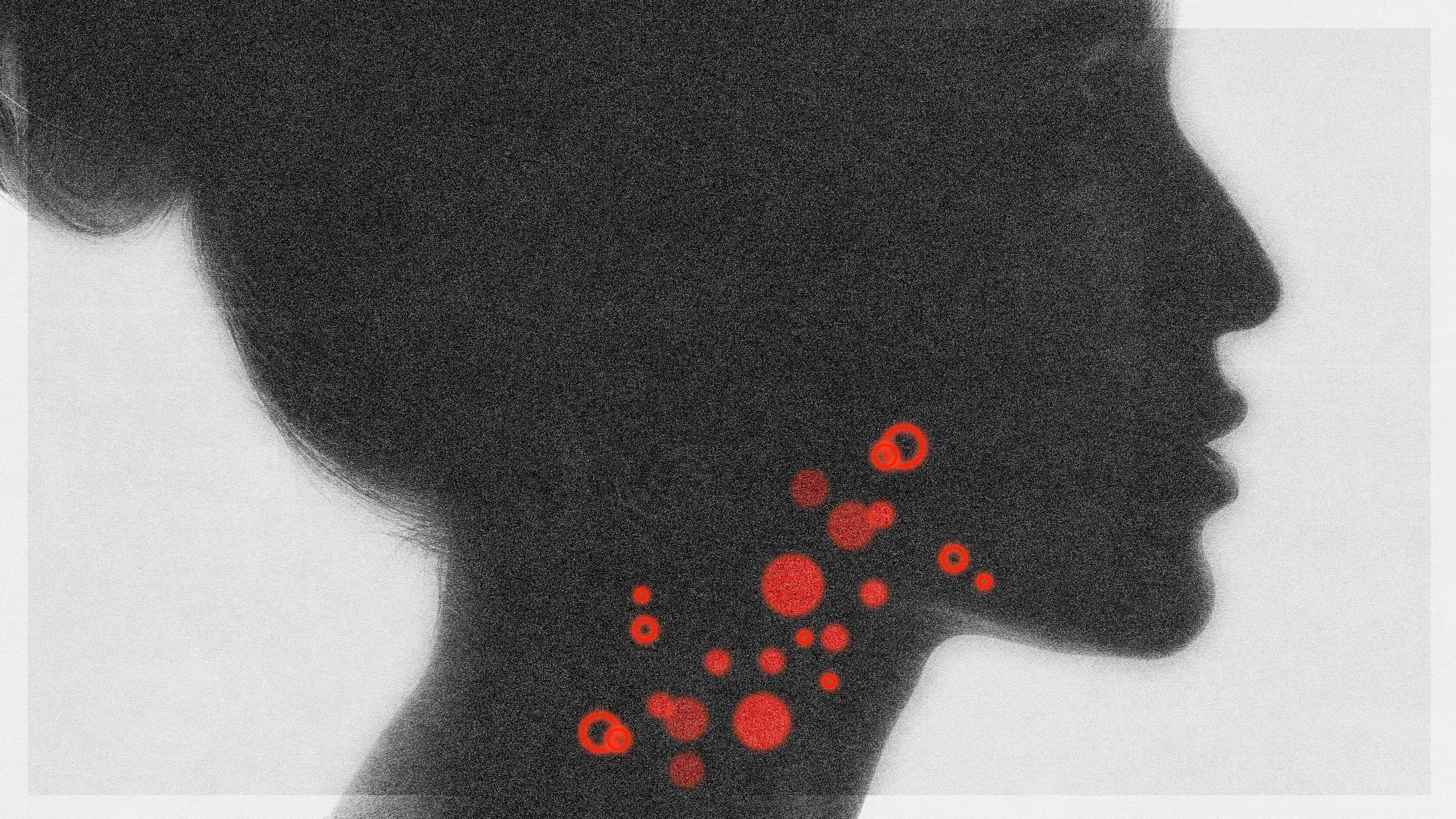Monkeypox and Skin Scarring: What You Need to Know
Can the most identifiable symptom of monkeypox—pus-filled lesions—lead to scarring?


On August 1, New York City Mayor Eric Adams issued an emergency executive order declaring a local state of emergency due to the monkeypox outbreak. It was alarming.
This year, more than 18,000 cases have been reported in the U.S. Along with fever and body aches, among other symptoms, people with monkeypox tend to experience a rash resulting in red bumps on the skin that can transform into painful pus-filled red papules (raised lesions). As the virus continues to spread, it’s important to know how to protect yourself from a potential outbreak, and how to care for a scar if you are infected. Here’s what we know about how monkeypox can affect your skin.
What is monkeypox?
Monkeypox is a disease caused by the virus of the same name. Like many diseases and infections, Monkeypox can be spread by skin to skin contact. It is also spread through sexual contact, with the virus transmitting through the mucous membranes of the mouth, anus, or vagina.
Generally speaking, monkeypox starts with a fever and flu-like symptoms, and according to the American Academy of Dermatology Association, it can follow with a rash that appears on the face (but not always emerging there first) and can spread throughout the body. Currently, there isn’t a treatment approved by the U.S. Food and Drug Administration for monkeypox, but the CDC suggests receiving JYNNEOS, a two-dose vaccine, if you have been exposed to monkeypox.
What does the monkeypox rash look like?
Most people with a monkeypox infection show symptoms, predominantly a highly contagious face and body rash that lasts for two to four weeks. “The rash consists of small 2 to 5 millimeter round flat red or discolored areas that become elevated and then fill with fluid and then pus,” says Michelle Forcier, M.D., of FOLX Health. “The rash usually starts on the face, and then develops on the palms of the hands and soles of the feet. It can also be found near the mouth, eyes, anus, and genitals.”
According to the Centers for Disease Control and Prevention, a monkeypox rash (also referred to as a lesion) progresses through four stages—macular, papular, vesicular, to pustular—before scabbing over. Then the outer layer of skin begins to replace itself.
Here are the six stages of a monkeypox rash:
Get exclusive access to fashion and beauty trends, hot-off-the-press celebrity news, and more.
- Enanthem (initial exposure): Lesions form on the tongue and in the mouth.
- Macules (1−2 days): Macular (flat) lesions appear.
- Papules (1−2 days): Lesions typically progress from macular to papular (raised).
- Vesicles (1−2 days): Lesions are often raised and filled with clear fluid.
- Pustules (5−7 days): Lesions are filled with opaque fluid and are firm to the touch.
- Scabs (7−14 days): Pustules crust and create a scab. Scabs will remain for about a week before beginning to fall off.
In previous outbreaks reported in central and western African countries, monkeypox could garner between 10 and 150 pox-like papules on one person, with some developing more than 200 bumps. The current U.S. outbreak hasn’t fostered such numbers. But regardless of the amount of lesions, they can be itchy and painful, especially once they crust over with a scab. The good news is when the scabs fall off and the skin beneath them is healed, you are no longer considered infectious, says Forcier.
Can a monkeypox rash cause scarring?
The short answer is yes. While not all monkeypox lesions will scar, scarring can occur. “It’s very similar to chickenpox. Most lesions will fade completely over time. However, if a lesion is traumatized before it resolves, it can heal as an atrophic scar (indented/depressed into the skin), a hypertrophic scar (elevated above the skin), hyperpigmented macule (flat dark spot), or a hypopigmented macule (flat light spot),” says Jennifer David, D.O., of Dermatology Partners Bensalem PA and founder of Skin & Scripts Virtual Dermatology.
If you contract monkeypox and have a healthy immune system, the scarring will likely fade on its own over time, but don’t scratch the rash, which will make it harder for the skin to recover and potentially lead to deeper tissue damage. Essentially, you want to treat monkeypox like you would any other wound or scar, and avoid picking, squeezing, or applying irritating topical products like AHA/BHA exfoliating acids, and retinoids.
How can you minimize monkeypox scarring?
Avoid picking the lesion because monkeypox can be spread through contact with the fluid inside the lesions. If you find that the scar is painful and itchy, opt for soothing topical products that include petrolatum (Aquaphor, Vaniply Ointment, and Vaseline) and hydrating humectants (think: lotions with ceramides, aloe, and/or hyaluronic acid as ingredients). “I would also recommend avoiding using exfoliants such as glycolic acid or salicylic acid as these will be too irritating,” says David. “These can be used later to help clear any dark spots of hyperpigmentation once the skin lesions fully heal.”
Relax, not all rashes are monkeypox
There are some skin conditions that look like monkeypox, but aren’t. If you notice a foreign rash on your skin, don’t assume it’s monkeypox—there are a multitude of other harmless infections. For instance, chickenpox can look similar, but it typically has smaller blisters and will not transition into pustules. “Severe acne can present as pustules, however it would be confined to the face, chest and back,” says David. “Monkeypox lesions will spread to the entire body, including the palms and soles. And shingles (herpes zoster) is a reactivation of the chickenpox virus. The rash will start off as small blisters but follow a linear path on the skin and only affect one side of the body.”
The bottom line: Regardless of your symptoms, monkeypox should not be taken lightly. If you believe you've been exposed, discuss your concerns with a health care provider and request a physical exam.
Meet The Experts

Michelle Forcier is a Clinician at FOLX Health, a healthcare service provider built to serve the community's specific needs. She received her medical degree from the University of Connecticut School of Medicine, Pediatric residency at University of Utah, obtained a Master’s in Public Health and completed a Robert Wood Johnson Clinical Scholars fellowship and Preventive Medicine residency at the University of North Carolina. She has been providing adolescent health services, specializing in sexual health care since 1997. Her professional background has focused on sexual health issues including: lesbian, gay, bisexual, transgender, queer and questioning youth with a focus on gender nonconforming youth, puberty blockers and hormones; contraception and advanced family planning; pediatric and adolescent gynecology; and transition medicine for older youth with complex medical problems. She has been involved in medical education and training at Brown University, Northwestern University and University of North Carolina Chapel Hill for over 15 years.

Dr. Jennifer David is a graduate of Temple University in Philadelphia, where she received a Bachelor of Arts in medical anthropology. Dr. David holds a Doctor of Osteopathic Medicine degree from the Philadelphia College of Osteopathic Medicine. While in medical school she also earned a Master of Business Administration from St. Joseph’s University, where she concentrated in healthcare management. She completed research fellowship with her mentor Dr. Susan Taylor, MD where she honed her passion learning the intricacies and nuances in treating skin of color. She then completed her residency training at Larkin Community Hospital in Miami, Florida where she served as chief resident in her final year. Throughout her training Dr. David remained active in research publishing numerous articles in peer-reviewed journals in addition to co-authorship in chapters for dermatology textbooks. Currently, Dr. David is a board certified dermatologist who remains active in the dermatology community holding memberships and leadership roles in the Women’s Dermatology Society, American Academy of Dermatology, The American Osteopathic College of Dermatology and Skin of Color Society, where she currently serves as chair of patient education committee.

Deena Campbell is the Beauty Director of Marie Claire where she oversees all beauty and health content on all platforms. Deena is a leader who is passionate about driving conversations on beauty topics, and is particularly dedicated to ensuring BIPOC feel seen and that their stories are told. Deena joined Marie Claire after a decade-long career as an editor in print and digital media. Before joining the brand, she managed editorial content for L’Oréal owned Makeup.com and Skincare.com where she led and developed a team of beauty editors and edited their contributions. She also crafted and successfully executed comprehensive brand strategies that resulted in brand growth and differentiation, a skill she currently brings to Marie Claire.
In 2015, she launched Essence.com’s hair channel where she received Time Inc.'s Henry R. Luce Award, shortly before joining Allure.com’s staff as Senior Beauty Editor. Along with her editorial positions, she also consulted on content and marketing strategies for beauty companies including DevaCurl and Dove, and has appeared at various speaking events and live television segments. Her writing has appeared in The New York Times, Byrdie, SELF, Refinery29, Teen Vogue, and a host of others. She graduated with a Bachelor of Arts in Journalism from the University of Pittsburgh and lives in New Jersey with her husband and two children. You can find her on Instagram at @deenacampbell.